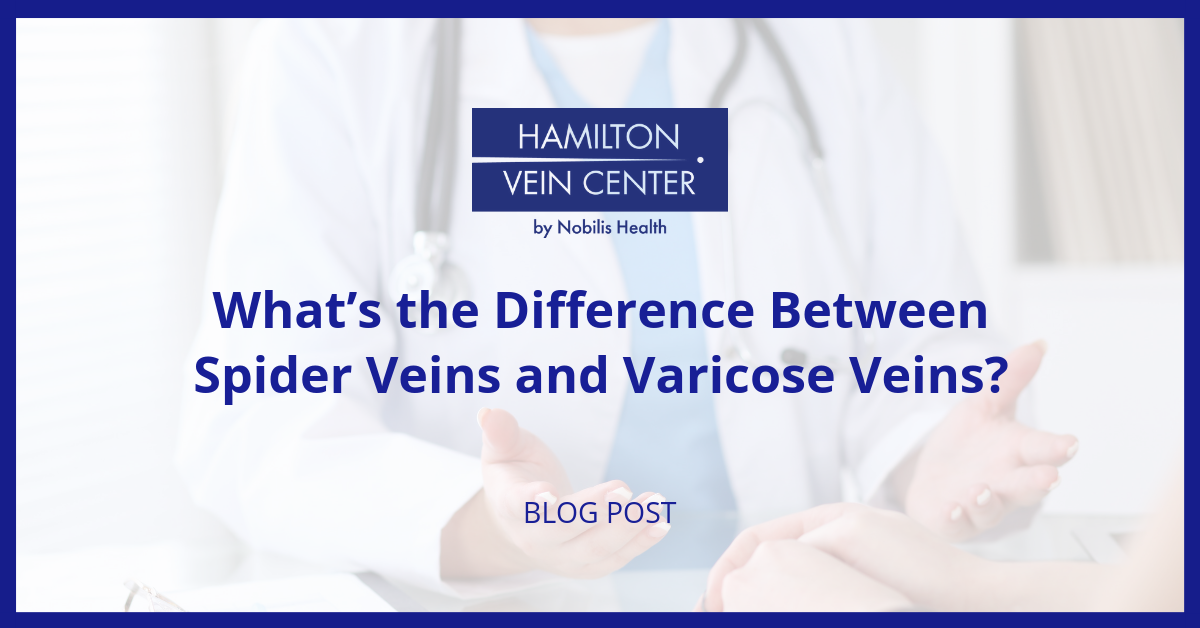What’s the Difference Between Spider Veins and Varicose Veins?

Widespread Issues
Of the many vein disorders that people suffer with, varicose veins and spider veins are among the more prevalent. Occurring in the legs, both conditions can become unsightly and uncomfortable, sometimes leading to a host of serious complications. And cases of these are surprisingly common, with an estimated 30 to 60 percent of adults displaying symptoms of one or both. [1] As such, it’s worth spending time learning more about them.
Perhaps the biggest question among patients is: What’s the difference between spider and varicose veins? Let’s clear that up.
Different Signs & Symptoms
Since these are both circulation disorders, it’s important to note that while causes may be related, symptoms are a little different. Here’s a quick breakdown:
- Spider Veins: These are recognizable as small purple, blue, or red veins often in star or “spider” shapes. They usually occur in the legs, though sometimes pop up on the face. They tend to occur more often in women and those who are overweight. Causing some pain and itchiness, they result from damage to smaller veins. These are more common than varicose veins.
- Varicose Veins: Also more often found in women and those who are overweight, these, in many ways, are a more extreme version of spider veins. With this condition, larger veins in the legs are swollen, discolored, and twisted up. They tend to cause more pain, as well as itchiness and heaviness in the legs.
Basically, the level of disruption in your daily life with varicose veins is going to be greater; however, there’s no denying that spider veins are also uncomfortable.
Common Causes
As noted, the causes and risk factors of these conditions are much the same. At the root of it, both conditions are disorders of blood circulation. They occur when blood in the legs is unable to properly get back to the heart, due to weakness in the vein walls. This causes the veins to pool and essentially get stuck in areas of the lower limbs, which is what leads to swelling and other symptoms. In many ways, then, spider veins are a less-extreme and advanced version of varicose veins.
Like causes, risk factors for both are common:
- Family history of varicose or spider veins.
- Work that involves standing for long periods of time.
- Being overweight or obsess.
- Gender, with these occurring more often in women.
- Being older.
- Menstruation or menopause in women.
- Pregnancy.
- The use of birth control pills.
- A history of blood clots or other venous disorders.
What these have in common is that they affect how well your body is able to healthily circulate blood.
Untreated Cases
Why is it important to get varicose and spider veins treated? Obviously, there’s quality-of-life to consider: ridding legs of unsightliness, pain, and discomfort will improve day to day living. Beyond that, there is some risk of varicose veins leading to a dangerous blockage of deeper veins called deep vein thrombosis (DVT), which can be lethal. In addition, some symptoms of more serious heart problem are similar to those of these conditions.
When is it absolutely critical for you to seek help for your condition? Here’s a quick breakdown:
- Skin Ulcers: These occur around the ankles and are wounds that refuse to heal.
- Swelling: Major swelling in the legs accompanied by varicose or spider veins can be a sign of more serious heart problems.
- Reddened Veins: If the veins are red, swollen, and very painful, seek out medical attention.
- Bleeding: If there’s blood coming from veins or close to them, you’ll want to get help.
It’s also important to note that these conditions are progressive; they can get worse over time if you don’t manage them.
A Continuum
Basically, then, spider and varicose veins are different expressions of the same underlying problem: circulation. Their scale is different—varicose veins are more disruptive—but what’s important is that they’re taken seriously. A range of treatment and management options are available, and there’s no reason spider or varicose veins should get in the way of your health.
If you suffer from varicose and spider veins, you can find help at Hamilton Vein Center. The experts at these Texas-based outpatient clinics employ the latest and best in minimally-invasive treatment methods for these conditions. They’ve helped countless patients get back on their feet! Learn more about what they do by calling their Houston location at (281) 565-0033, the Austin office at (512) 551-1403, or San Antonio at (210) 504-4304.
References
“Varicose Veins: Overview”. 2016. Institute For Quality And Efficiency In Health Care (Iqwig). https://www.ncbi.nlm.nih.gov/pubmedhealt